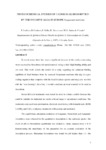Mostrar o rexistro simple do ítem
Physicochemical Studies of Cadmium(II) Biosorption by the Invasive Alga in Europe, Sargassum Muticum
| dc.contributor.author | Lodeiro, Pablo | |
| dc.contributor.author | Cordero Pérez, Bruno | |
| dc.contributor.author | Grille Cancela, Zulaika | |
| dc.contributor.author | Herrero, Roberto | |
| dc.contributor.author | Sastre de Vicente, Manuel | |
| dc.date.accessioned | 2005-11-04T19:09:31Z | |
| dc.date.available | 2005-11-04T19:09:31Z | |
| dc.date.issued | 2004 | |
| dc.identifier.citation | Biotechnology and bioengineering,2004, vol. 88, iss. 2, p. 237-247 | es_ES |
| dc.identifier.issn | 1097-0290 | |
| dc.identifier.issn | 1464-3383 | |
| dc.identifier.uri | http://hdl.handle.net/2183/174 | |
| dc.description.abstract | [Abstract] In recent years, there has been a significant increase in the studies concerning brown seaweed as biosorbents for metal removal owing to their high binding ability and low cost. This work reports the results of a study regarding the cadmium binding equilibria of dead biomass from the seaweed Sargassum muticum; this alga is a pest fouling organism that competes with the local fucalean species and may also interfere with the “sea industry”; therefore, it would constitute an ideal material to be used as biosorbent. Seven different treatments were tested in order to obtain a stable biomass that could be suitable for industrial use under a broad range of operational conditions. The treatments employed were protonation, chemical crosslinking with formaldehyde, KOH, Ca(OH)2 and CaCl2 or physical treatments with acetone and methanol. The equilibrium adsorption isotherms of Langmuir, Freundlich and Langmuir-Freundlich, were obtained for the quantitative description of the cadmium uptake. The effect of pH on biosorption equilibrium was studied at values ranging from 1 to 6, demonstrating the importance of this parameter for an accurate evaluation of the biosorption process. Maximum biosorption was found for pH higher than 4.5. The 1 maximum biosorption uptake for the raw biomass was 65 mg⋅g-1, while for formaldehyde crosslinking biomass the uptake increases to 99 mg⋅g-1 and for protonated biomass to 95mg⋅g-1. Potentiometric titrations were carried out to estimate the total number of weak acid groups and to obtain their apparent pK value, 3.85, using the Katchalsky model. Kinetic studies varying cadmium concentration, algal dose and ionic strength were carried out. Over 95% of the maximum cadmium uptake was achieved within 45 minutes, so the process can be considered relatively fast. A pseudo-second order model, for the kinetics of cadmium biosorption, showed to be able to reproduce experimental data points with accuracy. | es_ES |
| dc.description.sponsorship | Ministerio de Ciencia y Tecnología; BQU2002-02133 | |
| dc.description.sponsorship | Xunta de Galicia; PGDIT02TAM10302PR | |
| dc.format.mimetype | application/pdf | |
| dc.language.iso | eng | es_ES |
| dc.publisher | Wiley Interscience | es_ES |
| dc.relation.uri | https://doi.org/10.1002/bit.20229 | es_ES |
| dc.rights | Published in Biotechnology and bioengineering | |
| dc.subject | Biosorption | es_ES |
| dc.subject | Sargassum muticum | es_ES |
| dc.subject | Cadmium (II) | es_ES |
| dc.subject | Kinetics | es_ES |
| dc.subject | Equilibrium | es_ES |
| dc.subject | Acid base properties | es_ES |
| dc.subject | Crosslinking | es_ES |
| dc.title | Physicochemical Studies of Cadmium(II) Biosorption by the Invasive Alga in Europe, Sargassum Muticum | es_ES |
| dc.type | info:eu-repo/semantics/article | es_ES |
| dc.rights.access | info:eu-repo/semantics/openAccess | es_ES |






